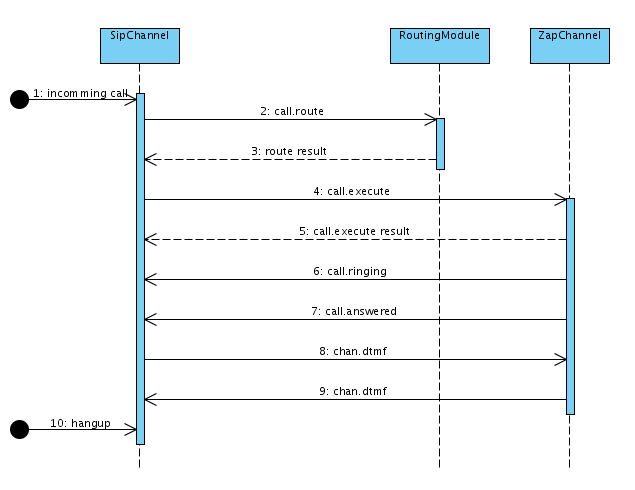Message Flows
(→Hangup) |
(tried to improve wording) |
||
| (4 intermediate revisions by 2 users not shown) | |||
| Line 1: | Line 1: | ||
| + | |||
| + | This page describes the flow of the messages for an incoming call. The flow is the same no matter the protocol used by the incoming call or to which protocol the call will go to. | ||
===Incoming Call Setup=== | ===Incoming Call Setup=== | ||
| Line 8: | Line 10: | ||
===Routing=== | ===Routing=== | ||
| − | When a channel detects incoming call(1), it sends [[call.route]](2) | + | When a channel detects an incoming call(1), it sends a [[call.route]](2) message for a decision on where the call should be routed to. The call.route message maps a called number to a call target. |
===Connecting=== | ===Connecting=== | ||
| − | When the call target is known, incoming channel attaches its CallEndPoint to [[call.execute]] message(4). | + | When the call target is known, the incoming channel attaches its CallEndPoint to a [[call.execute]] message(4). On receiving this message, the destination channel connects its own CallEndPoint to the CallEndPoint of the incoming channel. While waiting for call acceptance, the destination channel may send [[call.ringing]](6). On call acceptance [[call.answered]](7) is sent. |
===During the call=== | ===During the call=== | ||
| Line 20: | Line 22: | ||
===Hangup=== | ===Hangup=== | ||
| − | When incoming channel detects hangup(10) it disconnects its CallEndPoint. | + | When the incoming channel detects hangup(10), it disconnects its CallEndPoint. This results in [[chan.disconnected]] and eventually [[chan.hangup]] messages (not included in the diagram) sent by both channels. |
| + | |||
| + | |||
| + | '''See also''' | ||
| + | |||
| + | * [[Messages]] | ||
| + | |||
| + | [[Category:Messages]] [[Category:Programmers]] | ||
Latest revision as of 23:07, 10 March 2014
This page describes the flow of the messages for an incoming call. The flow is the same no matter the protocol used by the incoming call or to which protocol the call will go to.
Contents |
[edit] Incoming Call Setup
Flow of messages:
[edit] Routing
When a channel detects an incoming call(1), it sends a call.route(2) message for a decision on where the call should be routed to. The call.route message maps a called number to a call target.
[edit] Connecting
When the call target is known, the incoming channel attaches its CallEndPoint to a call.execute message(4). On receiving this message, the destination channel connects its own CallEndPoint to the CallEndPoint of the incoming channel. While waiting for call acceptance, the destination channel may send call.ringing(6). On call acceptance call.answered(7) is sent.
[edit] During the call
During the call chan.dtmf messages(8,9) may be sent in both directions.
[edit] Hangup
When the incoming channel detects hangup(10), it disconnects its CallEndPoint. This results in chan.disconnected and eventually chan.hangup messages (not included in the diagram) sent by both channels.
See also
